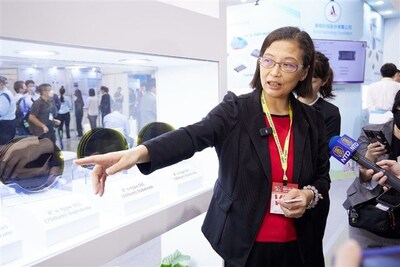China holds a dominant position in the two major application areas for SiC—EVs and solar panels. The Chinese government is aggressively pursuing semiconductor self-sufficiency, raising concerns about the future viability of non-Chinese systems. Taiwanese companies, which have been slower to develop, may navigate this crisis of excess SiC materials, but they face a mixed bag of opportunities and challenges, particularly with the looming threat of large-scale, low-cost competition from China.
Doris Hsu, chairperson of Sino-American Silicon Products (SAS) and GlobalWafers, admitted that the changes in the SiC industry this year were unexpected, particularly due to substantial capacity increases from Chinese manufacturers driving prices to unprecedented lows.
Hsu analyzed the landscape through two lenses: geopolitics and the characteristics of the SiC industry. She believes that this is a pivotal moment for Taiwanese manufacturing to assert its advantages. Geopolitically, the US, Europe, and Japan are actively seeking to reduce reliance on Chinese suppliers, making it less likely that SiC will follow the trajectory of solar energy. These regions are looking for allies to create a more balanced ecosystem, and they see potential in Taiwan.
Taiwanese companies boast stable quality and reliability, and their established presence in silicon-based (Si) semiconductor markets is well-recognized globally. The rigorous manufacturing standards seen in these sectors can be applied to SiC. In terms of product performance and cost-effectiveness, Taiwanese firms generally outshine their European, American, and Japanese counterparts, though the latter still maintain irreplaceable advantages in specific applications, suggesting a complementary approach could yield optimal results.
From an industrial perspective, Hsu emphasized that the SiC sector differs from solar energy and LED sapphire. In solar modules, if one cell malfunctions, the remaining cells can still function, resulting in a reduced power output. Conversely, SiC primarily serves medium- to high-voltage power demands, making its role crucial as power grids adjust to increasingly volatile electricity inputs. Safety is paramount in automotive applications, and any compromises are unacceptable. Errors in industrial-grade power networks can lead to significant economic losses from sudden outages, while automotive standards prioritize driver and pedestrian safety, exposing Tier 1 suppliers and automakers to substantial liabilities.
Consequently, many mid to high-end Chinese electric vehicles continue to favor SiC components from international integrated device manufacturers (IDMs), even while adhering to government policies. These manufacturers must prioritize safety and reliability, requiring effective testing and validation before incorporating SiC components into vehicles. No automaker or utility would willingly accept the substantial risks associated with a single SiC component threatening their operations.
In summary, the SiC industry must focus not only on material prices but also on meeting customer expectations for quality and reliability. Currently, SiC substrates are experiencing temporary irrational low prices due to supply-demand imbalances. Despite this, Hsu recognizes the scale and cost- competitive strengths of Chinese SiC manufacturers, predicting that other supply chains, including Taiwan's, will struggle to match their cost-effectiveness. As SiC substrate prices continue to fall, the range of applicable sectors is set to expand, moving beyond just electric vehicles and solar modules.
![]() View original content to download multimedia:
https://www.prnewswire.com/news-releases/sic-prices-plunge-as-chinese-capacity-soars-reshaping-semiconductor-landscape-302288377.html
View original content to download multimedia:
https://www.prnewswire.com/news-releases/sic-prices-plunge-as-chinese-capacity-soars-reshaping-semiconductor-landscape-302288377.html
SOURCE DIGITIMES ASIA
| Contact: |
| Company Name: DIGITIMES ASIA
Email Contact |










